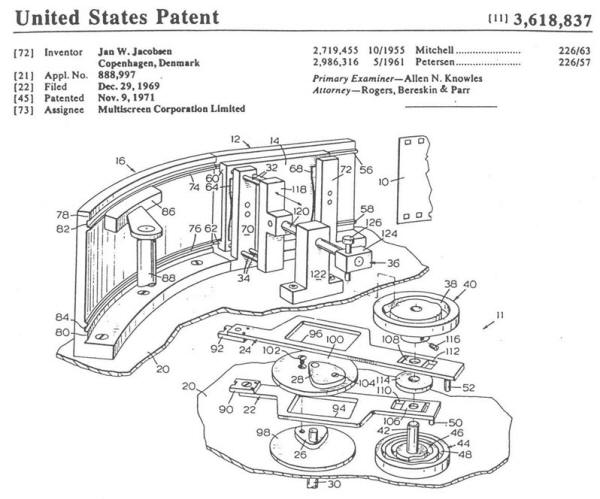Jan Jacobsen - His Story |
This article first appeared in |
| Written by: Mr. William. C. Shaw, IMAX Corporation, September 4, 1998 | Issue 54 - September 1998 |
 Drawing of Jacobsen's IMAX camera movement. Patent
filed December 29, 1969.
2x 7˝ perf 15 perf movement
developed in Copenhagen, Denmark 1967-69 Drawing of Jacobsen's IMAX camera movement. Patent
filed December 29, 1969.
2x 7˝ perf 15 perf movement
developed in Copenhagen, Denmark 1967-69Before 1968, Jan Jacobsen had built a good reputation, designing & building compact, light-weight cameras, camera lenses (anamorphs), and special effects equipment. His cameras contributed to the success of a number of films, including: • "Switzerland - Fortress of Peace" Jan built a compact 5-perf 65mm camera for a Vampire jet nose mount. • "2001: A Space Odyssey" He did special effects work for Stanley Kubrick, including the opening shot. • "Battle Of Britain" He built (5) compact 5-perf 65mm cameras for Harry Saltzman, to achieve all the aerial shots in this film. When the founders of Imax Corporation (Graeme Ferguson, Robert Kerr and Roman Kroitor) began searching for technical solutions to make a practicable large-format motion picture system, Bob Gaffney suggested they contact Jan. Graeme met Jan in Munich early in 1968, and asked if he could enlarge his 5-perf 65mm design to 8-perf. This would have suited optical "blow up" printing of 15-perf 65mm and contact printing from the IN to 15-perf 70mm release prints. Jan suggested another approach, saying,
So......... He went to work in his shop in Copenhagen and, within 4 months,
showed Graeme a very compact camera, based on a tandem 7-1/2 perf mechanism.
On Dec. 3, 1968, Jan delivered the camera to Galt, Ontario, Canada, home of
Multiscreen Corporation (the original name of Imax Corporation). |
Further in 70mm reading: |
|
Go: back
- top - back issues Updated 22-01-25 |
